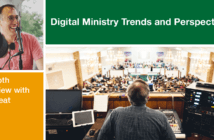Many churches have a one-size-fits-all approach to their annual stewardship appeal. Everyone in the congregation receives the same “Dear Friend” letter inviting them to prayerfully offer up their tithe to the church for the coming year. While this approach is simple and easy to execute, it’s generally not the most effective or meaningful way to communicate with people about their giving.
Your church members are much more likely to think seriously about their giving to thechurch when they receive an appeal that meets them where they are.
This approach ignores the reality that in every church there are people at various points along the journey toward becoming faithful stewards. Some may be life-long tithers. Some have given faithfully for years. Others have never made a financial contribution, much less a pledge. Approaching these different kinds of givers with the same appeal just doesn’t make sense from a spiritual or a developmental perspective.
When planning a commitment campaign, I generally think about several different categories of givers, each needing to receive a slightly different message.
Most generous givers or tithers. In every church, a small percentage of generous contributors provides a very significant proportion of what is given. These givers, above all else, deserve to be thanked. In all likelihood, they are the most prone to increase their giving, so it’s important to acknowledge how important their continued generosity is in sustaining the church’s ministry.
Pledgers with room to grow. These givers, too, deserve to be thanked. But they also need to hear how growing in giving will help them mature spiritually and connect them more meaningfully to God’s work in and through the church. Explain to them why it’s important to give in proportion to their income as they grow toward the goal of tithing or sacrificial giving.
People who contribute to the church but do not pledge. These givers also deserve to be thanked, of course. But the message they need to hear is why it’s important to make a pledge — not because the church needs their pledge to build the budget — but because a pledge is a promise to themselves and to God that helps them be more faithful in the spiritual practice of giving.
Non-contributors. As shocking as it may seem, every church has a substantial cohort of people who don’t give at all. It makes little sense to ask these people to begin by giving ten percent of their income, or even by making a pledge. People almost invariably give before they become pledgers or tithers. So invite these people to support the church with a gift. Let them know of the good work their giving will support. Don’t shame or belittle them. Assume they are part of your church for a reason, and they just need a little encouragement to get started.
New members. If someone is new to your community and being asked to make a commitment for the first time, this is a wonderful opportunity to explain to them why church members are asked to pledge and how the commitment process works. The message can be welcoming and invitational in tone.
In addition to composing letters along these lines, it can be helpful to keep these categories in mind if your campaign plan involves group gatherings to discuss commitments. People won’t find it a bit odd to be in a meeting with other people whose relationship to the church is similar to their own, and they will appreciate hearing a message about giving that makes sense given their situation.
Yes, this means that the pastor or someone else needs to be paying attention to who’s who, where they are spiritually, and what they give. In fact, the need to communicate with people about their giving in meaningful and appropriate ways is one of the best arguments in favor of allowing responsible people proper access to giving records. See Should a Pastor Know What Church Members Give?
And yes, this approach takes more work. But it’s well worth it. Your church members are much more likely to think seriously about their giving to the church when they receive an appeal that meets them where they are, both spiritually and in terms of their giving history.
![]() Download a one-page To the Point of this article to share with others.
Download a one-page To the Point of this article to share with others.
Related Resources:
- Should a Pastor Know What Church Members Give? by Ann A. Michel
- Paying Attention to Those Who Give and Those Who Don’t by Steve Wende
- 50 Ways to Improve Your Annual Stewardship Campaign






